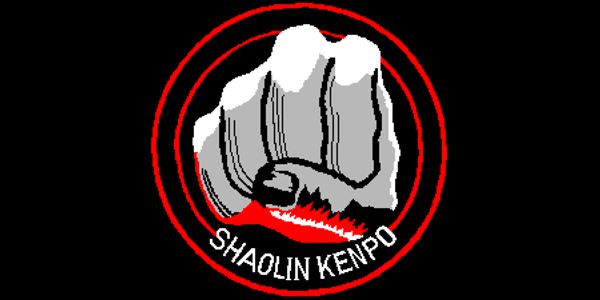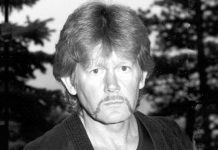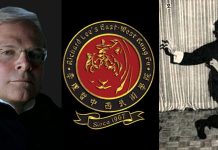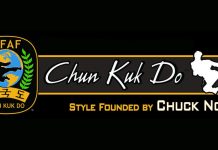By Jane Hallander – Inside Kung Fu Magazine ~ Kenpo, sometimes known as “kenpo karate” or “Chinese kenpo karate,” has developed into one of the most popular martial arts in the United States, which itself is remarkable for a fighting art that came to the United States from Hawaii only a few decades ago.
Kenpo was taught by Professor William Chow in Hawaii and crossed over to the mainland with distinguished students such as Ed Parker, Adriano Emperado, and Ralph Castro, where the art has become modified slightly within each school that teaches it. Some schools have added judo throws and jujitsu locks to the art. Others have brought more of a Japanese and Okinawan influence to kenpo, giving it the solid stances and linear attacks of a karate system. One of Chow’s students, however, has maintained kenpo in the same manner that Chow taught it. That person is Ralph Castro, a high-ranking black belt in kenpo, who at his Ralph Castro’s Kenpo Karate Studio in Daly City, California, is teaching “Shaolin Kenpo,” a form of kenpo that he maintains is the unchanged, true kenpo as taught by Professor Chow.
Castro first studied with Chow in 1955 and has periodically returned through the years to Hawaii to train with him. His bond with Chow is so strong that Chow, at age sixty-seven, is retiring and coming to California to live with the Castro family and serve as an advisor at the Castro kenpo school.
Chow has recently requested that Castro change the name of the system from “kenpo karate” to “Shaolin Kenpo.” Chow’s own previous training included ten years of Shaolin kung-fu, and he originally intended kenpo to contain only Chinese stances and techniques, rather than those of Japanese or Okinawan style. He developed kenpo as an American offshoot of kung-fu, designed to blend with modern self-defense demands, but still remain a traditionally Chinese art. Hence the new name, Shaolin Kenpo. He feels that placing the emphasis on Japanese and Okinawan influences, as some have done, has markedly changed his original concept for the art. Shaolin Kenpo is described by Ralph Castro like this: “Just as it is possible to use a gun for many different purposes–target shooting, hunting, or law enforcement–Shaolin Kenpo has always been structured to serve many different purposes such as sport competition, self defense, and to include the offensive movements necessary for a well rounded fighting system.”
To the trained eye, it does look a lot more like kung-fu than other kenpo systems. There are a lot of long-range hand strikes that remind the observer of some kung-fu systems, instead of the short-hand, inside fighting techniques often associated with kenpo karate. Shaolin Kenpo techniques rely on a great amount of speed and power, coupled with the idea that instead of having only a one-two punch-kick combination, the student learns five and six-combination strikes. The theory is, “If you miss, you don’t have to stop and regroup,” according to Castro. The end result would be the ability to launch a series of five or more strikes, directed at more than one attacker, in lightning-fast sequence. Castro’s feeling about the use speed in Shaolin Kenpo is summed up thusly: “To be prepared to defend yourself in a street situation against more than one attacker, you must be able to use a lot of speed with your attacks. In that respect, speed becomes more important than power, but as the student gains speed and accuracy he also gains power in his punches.
The differences between Shaolin Kenpo and other kenpo Systems are immense. The Stances are unmistakably Chinese. The Shaolin Kenpo student moves quickly and lightly in the manner of the Chinese arts to avoid the attacker’s onslaught altogether, rather than apply the Japanese tactic of meeting attacks with a solid frontal defense. The Shaolin Kenpo student frequently circles quickly, continuously bombarding his opponent with an onslaught of blows calculated to find or create an opening in the opponent’s defense. This type of attack is characteristically Chinese and completely unlike the Japanese and Okinawan concept of a more straight-forward, harsher, and angular push-pull block and punch combination.
The foot techniques used in Shaolin Kenpo also bear a strong resemblance to those used in kung-fu. A straight front kick is frequently used, often in the form of a kick to the opponent’s groin. Side kicks are also popular, here again not so much to the head, which would complicate balance, but lower, directed more at body targets. On the other hand, the popular roundhouse kick is not emphasized in Shaolin Kenpo. Castro admits to a little creativeness with his art, in that he has borrowed from the karate-based arts the spinning back kick. He likes it, not only because of its attractive, flowing appearance, but also because of its speed and potential effectiveness.
The kicks are applied in conjunction with the hand movements, thereby breaking the opponent’s concentration on the hand strike or kick that could end the fight. This follows the Chinese way of thinking punches and kicks performed in conjunction with one another lead an opponent to expose himself while attempting to block one part of the combination.
The Shaolin Kenpo stylist also uses a wide variety of sweeps and leg blocks in his art. The sweeps include the low, 360-degree circle and the short, kick-like sweep–both are used to knock an opponent off balance. The leg blocks are also performed in conjunction with quick hand movements.
The emphasis in kenpo is generally on hand techniques, and Shaolin Kenpo is certainly no exception. The only difference is that Shaolin Kenpo places the emphasis on kung-fu types of hand movements. Although the system has closed fists (such as the straight punch and the backfist common to karate, kick-boxing and kung-fu), it leans heavily toward strikes imitating the animal forms so popular in kung-fu. The animal fighting forms are not usually part of Japanese or Okinawan fighting systems. Shaolin Kenpo contains a liberal amount of techniques based on the tiger, eagle, leopard, and dragon styles, again, with all of them bearing strong resemblance to certain Chinese martial arts.
One interesting difference between Shaolin Kenpo and karate is that the fighter’s guard hand is not kept at his hip to facilitate the “push-pull” action so common to Japanese systems. The guard hand is always kept in a circular protecting position in front of the body, as in most Kung-fu styles. This is a basic difference in philosophy, because the kenpo fighter, instead of relying on the kind of power developed by the push-pull hand techniques, must utilize his speed, agility, and quick footwork to evade, counter, and return the attack. This marks an important difference in theory between the Chinese and Japanese schools of thought.
Unlike a boxer, the Shaolin Kenpo stylist does not at any time stick or grapple with his opponent. He will, however, block the attacker’s blows in a manner that “sucks in” his opposition. He will be trying to render his assailant off balance, and one method of doing that is to pull him into range of the kenpo stylist’s barrage of blows.
The hand strikes in Shaolin Kenpo are much more circular than linear, as in the karate oriented systems. The arm motions are usually sweeping, long-range attacks allowing the Shaolin Kenpo practitioner to simultaneously block and attack. Remember that in order to fully utilize these circular hand movements he must be able to change direction quickly and smoothly. This emphasis is also very Chinese in character.
The method with which Shaolin Kenpo is taught constitutes another difference between that system and other styles. Castro introduces the student to some very quick effective combination techniques from the student’s very first day in the studio. In the beginning, there are no basics taught, just these techniques. Along with those techniques, Castro teaches the practical application and stresses development of speed. The new student gets an idea of the coordination between hand and footwork necessary in Shaolin Kenpo. After learning those initial combination techniques, the student is then taught the basics of the system. This foundation is something that he will be expected to constantly refresh himself in. One advantage of learning the important basic theories (such as speed and focus) of the system before learning the basic stances, hand strikes, and kicks is that the new student can immediately start to apply those concepts to the basics as he learns them. That way he gets the confidence and idea of how to effectively use what he is learning, even as he learns it.
Castro refers to the forms taught in Shaolin Kenpo as “sets,” as in kung-fu terminology, instead of using the Japanese term “kata.” The sets are designed to teach the student how to apply the techniques that he has learned, as well as to practice his form, speed, and balance. Shaolin Kenpo does not use the sets simply to practice the basics of the system, but makes them into practical flowing forms designed to simulate counters and attacks against many attackers. These sets are designed to be practiced either alone or with another kenpo stylist. Not only does Castro have his students practice their sets with an actual antagonist, but the sets themselves are structured to he used as the defensive or offensive counterpart to other Shaolin Kenpo sets. This means that a student might want to practice a set called “circle of iron” with another student, and the other student would use another kenpo set as the defensive side of “circle of iron.” Here again we have a situation that tends toward the kung-fu philosophy of the need to have two-man sets to teach focus, speed, and quick reactions.
The sets are structured to teach an important principle or technique to the kenpo student. The first set is titled “mountain meets river” and the student learns to he as strong as a mountain and to flow like a river. From there he progresses to sets such as “high river” where he develops strength and balance in his legs, and “river dam” where the student learns how to react when backed up against a walk. The animal forms come when the kenpo student has thoroughly assimilated the basics of the system. At that time he will start learning sets like “eagle flys low”; “fire dragons”; and “galloping horse.” These are all advanced sets designed to be used by the student who already has developed his confidence, speed, and power. Not only does the student use his forms training alone and against a partner, but he takes portions from his sets for use in tournament fighting. This links the practical applications of the techniques with the fighting movements derived from the forms.
This, according to Ralph Castro, is kenpo the way that Professor Chow intended it to be. Certainly, a lot of credence is lent to his statement by the fact that Chow is coming to live with the Castro family, and will have an opportunity to further show his kenpo to the mainland public. It is Chow’s primary concern that kenpo should be kept simple, direct, and traditional, and Shaolin Kenpo appears to fill that desire.
About the author: Jane Hallander is a freelance writer from the San Francisco area who has studied both kenpo and kung-fu extensively.

For more information about Ralph Castro’s Shaolin Kenpo Martial Arts visit their listing on the Martial Arts Schools and Businesses Directory by clicking on the image on the left.





